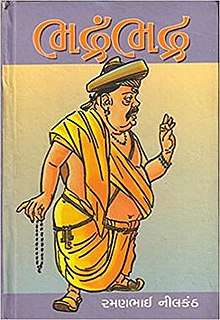Bhadrambhadra
 Book cover | |
| Author | Ramanbhai Neelkanth |
|---|---|
| Original title | ભદ્રંભદ્ર |
| Country | India |
| Language | Gujarati |
| Genre | Humorous novel |
| Published | 1900 |
| OCLC | 26376533 |
| 891.477 | |
Original text | ભદ્રંભદ્ર at Gujarati Wikisource |
Bhadrambhadra is a 1900 Gujarati satirical novel by Ramanbhai Neelkanth. It is regarded as the first humorous novel in Gujarati literature and as the first Gujarati novel written in the first person narrative. Ramanbhai used the novel to illustrate the ridiculousness of a highly orthodox view of Gujurati society and as a vehicle for social reform.
Although criticised for a lack of character development and a repetitiveness of situations, the novel has remained popular to this day. It has been republished numerous times and is currently in print in several languages. It is still common to nickname highly orthodox Sanskrit-accented Gujaratis after the eponymous protagonist.
Overview

Bhadrambhadra is a 1900 Gujarati language satirical novel by Ramanbhai Neelkanth.[1] It is regarded as the first humorous novel in Gujarati literature.[2][3] The novel is influenced by The Pickwick Papers and Don Quixote. Ramanlal had a long running controversy with Manilal Dwivedi on numerous topics related to religion, philosophy, social reform, education and literature.[4] Ramanlal was a liberal who was open to western influences while Manilal was an orthodox who opposed the western influences. Ramanbhai showed up the rigidity, pettiness, vanity and hypocrisy of these opponents of social reform in the book.[2][5] Ramanbhai Neelkanth's enthusiasm for social reform was strongly influenced by his father, Mahipatram Rupram Nilkanth, an educationist and social reformer.[6]
Bhadrambhadra was serialized from 1892 to 1900 in Jnanasudha, the organ of Ahmedabad Prarthana Samaj edited by Ramanbhai himself,[6] and then published as a book in 1900 with further amendments. Ramanbhai wanted to publish the first edition with paintings but was unable to. In 1918 the third edition of the novel was published with illustrations by Ravishankar Raval. The 7th edition, published in 1953 with a preface by Jyotindra Dave, did not have illustrations; only photographs of Ramanbhai and Ambalal, the publisher, were included in it. Further editions were published without illustrations or photographs.[7]
Synopsis
The novel is named after its protagonist, Bhadrambhadra. It is narrated in the first person by Ambaram Kevalram Modakiya, a pupil of Bhadrambhadra.[7] It is the first Gujarati novel to be written in the first person narrative.[8]
Bhadrambhadra is an orthodox Hindu Brahmin and an idiosyncratic person, who is opposed to anything that is non-traditional, non-Hindu, non-Sanskrit, non-Aryan or that is different from his traditional way of life or pattern of thoughts. Because of this, he changed his name from Daulat Shankar to Bhadrambhadra (lit. Good Good), as the word Daulat is non-Sanskrit, non-Indian and so, he felt, irreligious in origin.[2] In the novel Bhadrambhadra speaks highly Sanskritised Gujarati and therefore is not able to make himself understood, which creates humorous situations.[9]
Reception and criticism
Bhadrambhadra is considered a classic of Gujarati literature and it was received well by readers and a number of critics.[7] However, the Encyclopedia of Indian Literature states that there is no development of character, and because of a lack of variety of situations and of behavior by the protagonist, the humour is not sustained throughout and the latter half of the book becomes uninteresting.[9] K. M. Munshi gave a mixed review. He noted in Gujarat and Its Literature:
The story is poorly told in places and lacks organic unity. The work is rendered enjoyable by absurd situations and still funnier Samskritised Gujarati. Bhadrambhadra, the pretentious fool with his holy enthusiasm to secure the ever-rising glorious triumph of eternal Arya Dharma, is an immortal figure in Gujarati fiction.[10]
In popular culture
During Ramanbhai's life, the character Bhadrambhadra became very popular and anybody who spoke Sanskritised Gujarati was nicknamed Bhadrambhadra. It is still a common nickname for any highly orthodox person.[3][9]
References
- ↑ Mohan Lal (1992). Encyclopaedia of Indian Literature: Sasay to Zorgot. New Delhi: Sahitya Akademi. p. 3841. ISBN 978-81-260-1221-3. Retrieved 11 May 2018.
- 1 2 3 Mansukhlal Maganlal Jhaveri (1978). History of Gujarati Literature. New Delhi: Sahitya Akademi. p. 116.
- 1 2 K. M. George (1992). Modern Indian Literature, an Anthology: Surveys and poems. New Delhi: Sahitya Akademi. p. 128. ISBN 978-81-7201-324-0. Retrieved 11 May 2018.
- ↑ Thaker, Dhirubhai (1983). Manilal Dwivedi. Makers of Indian Literature. New Delhi: Sahitya Akademi. pp. 14–16, 35–36, 51. OCLC 10532609.
- ↑ Thaker, Dhirubhai (May 2011). "11. દ્વૈત-અદ્વૈત-વિવાદ" [Dualism-Nondualism controversy]. કેટલાક સાહિત્યિક વિવાદો [A Few Literary Controversies] (1st ed.). Ahmedabad: Gujarat Vishwakosh Trust. p. 60.
- 1 2 K. M. George, ed. (1997). Masterpieces of Indian literature. Vol. 1. New Delhi: National Book Trust. p. 351. ISBN 978-81-237-1978-8. Retrieved 5 March 2018.
- 1 2 3 Borisagar, Ratilal; Daru, Manoj (2001). Gujarati Vishwakosh (Gujarati Encyclopedia). Vol.14. Ahmedabad: Gujarati Vishwakosh Trust. p. 309.
- ↑ "સવિશેષ પરિચય: રમણભાઈ નીલકંઠ, ગુજરાતી સાહિત્ય પરિષદ". Gujarati Sahitya Parishad (in Gujarati). Retrieved 7 June 2018.
- 1 2 3 Amaresh Datta (1987). Encyclopaedia of Indian Literature: A-Devo. New Delhi: Sahitya Akademi. p. 418. ISBN 978-81-260-1803-1. Retrieved 8 May 2018.
- ↑ Munshi, Kanaiyalal Maneklal (1935). Gujarat and Its Literature. Calcutta: Longmans, Green & Co. Ltd. pp. 281–282.
External links
- Bhadrambhadra at Google Books
- Bhadrambhadra at GujLit